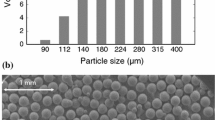Abstract
The abrasive wear of rubbers is strongly affected by the filler particles dispersed in the elastomer matrix. The fillers are incorporated usually for the purposes of mechanical reinforcement and improving the conductivity of the neat resins. It is found that the wear rates of the filled silicone rubbers increase slowly with filler concentration until a critical volume fraction,v c, is reached, at which point they increase very rapidly with increasing filler concentration. This behaviour appeared to be universal in all the filled silicones we studied, regardless of the type of filler and silicone rubber used. However the magnitude of the critical filler fraction,v c, can be changed significantly with the filler shape, resin cross-linking density and filler surface treatments. No reasonable relationship could be found between this wear behaviour and the mechanical properties measured in a macroscopic manner. Experimental evidence suggests that the incipient ‘cracks’ that lead to wear losses may start within the thin layers of highly stressed material, the ‘damage zones’, surrounding the rigid particles. A simple model taking into account the stress concentration induced by the rigid fillers shows excellent correlation between the wear rate and the damage zones volume. With this new model, the observed wear behaviours can be explained satisfactorily.
Similar content being viewed by others
References
A. Schallamach,Wear 1 (1958) 384.
J. K. Lancaster,J. Phys. D 1 (1968) 549.
Idem, Wear 14 (1969) 223.
S. B. Ratner andN. V. Melnikova,Kauchuk i Rezina 17 (1958) 14.
Idem, Rubber Chem. Tech. 32 (1959) 1199.
S. B. Ratner, I. I. Farberova, O. V. Radyukevich andE. B. Lure,Sov. Plast. 7 (1964) 37.
E. Southern andA. G. Thomas,Plast. Rubber Mater. Applic. 3 (1978) 133.
D. H. Champ, E. Southern andA. G. Thomas, in “Advances in Polymer Friction and Wear”, edited by L.-H. Lee (Plenum, New York, London, 1974) p. 133.
A. Schallamach,J. Appl. Polym. Sci. 12 (1968) 281.
A. N. Gent andC. T. R. Pulford,ibid. 28 (1983) 943.
A. N. Gent andB. Park,J. Mater. Sci. 19 (1984) 1947.
A. N. Gent andW. R. Rodgers,J. Polym. Sci., Polym. Chem. Ed. 23 (1985) 829.
M. K. Kar andS. Bahadur,Wear 30 (1974) 337.
K. Tanaka andS. Kawakami,ibid. 79 (1982) 221.
L. J. Broutman andR. H. Krock, “Modern Composite Materials”, (Addison-Wesley, Reading, MA, 1967) ch. 2.
J. N. Goodier,Trans. ASME 55 (1933) 7.
E. O. Hall,Proc. Phys. Soc. (Lond.) 64B (1951) 747.
N. J. Petch,J. Iron Steel Inst., Lond. 174 (1953) 25.
Author information
Authors and Affiliations
Rights and permissions
About this article
Cite this article
Yang, A.C.M., Ayala, J.E. & Scott, J.C. Abrasive wear in filled elastomers. J Mater Sci 26, 5823–5837 (1991). https://doi.org/10.1007/BF01130121
Received:
Accepted:
Issue Date:
DOI: https://doi.org/10.1007/BF01130121




